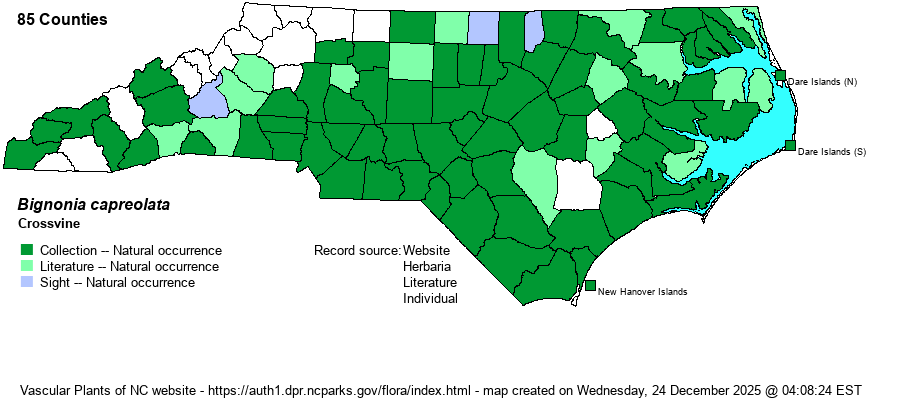| Author | L. | |
| Distribution | Throughout the Coastal Plain (though scarce in the far eastern counties), and nearly throughout the Piedmont, but absent to scarce in the northern foothills. Scattered in the southern half of the Mountains, but absent north of Madison County.
This is a Southern species, ranging north only to MD and southeastern MO, south to central FL and central TX.
| |
| Abundance | Common and widespread in most of the Coastal Plain and Piedmont; uncommon in the far eastern Coastal Plain. Absent to rare in foothill counties of the Piedmont (e.g., no known records for Stokes County southwest to Alexander County). Quite rare in the southern Mountains, but uncommon in the far southwestern counties (Cherokee and Graham). | |
| Habitat | This vine is found primarily in bottomland forests, floodplains, riverbanks, and streamsides; less often in seasonally inundated swamps, wet thickets, and more mesic, upland forests. |
| Phenology | Blooms in April and May, and fruits in July and August. | |
| Identification | This is a distinctive, high-climbing woody vine, usually evergreen or at least semi-evergreen in NC. The leaves are opposite and often are found on short side spurs; tendrils are present at the base of each leaf pair. The leaves are unusually shaped – though lanceolate to ovate (wider below the middle) like many other species, they have entire margins and have distinctive ear-lobed bases. Young vines and leaves can often be seen along the ground, but the species does not flower from ground vines. However, the very large and showy trumpet-shaped flowers – red on the outside and yellow on the inside (with a red throat) – grow in abundance once the vines have climbed trees to at least 10 feet off the ground. By late spring, the forest floor is often littered with the fallen flowers, which have a dusty odor. In late summer, very long and slender capsule “pods” appear; they are often about 5 inches long. | |
| Taxonomic Comments | Formerly was named as Anisostichus capreolata, but most recent references have moved in into the genus Bignonia.
| |
| Other Common Name(s) | Trumpet-flower | |
| State Rank | S5 | |
| Global Rank | G5 | |
| State Status | | |
| US Status | | |
| USACE-agcp | FAC link |
| USACE-emp | FAC link |

